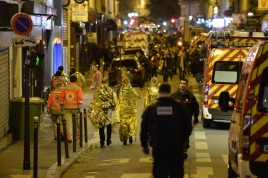
“The purpose of the Report is to bring together skills and know-how of various Research Centres, Institutes and Think tanks concerned with the evolving phenomena of radicalism and terrorism in Europe. The Report offers a multidisciplinary approach, the first at a national level, aimed at providing the most comprehensive definition of this phenomenon.”
 In this interview with SIR Claudio Bertolotti provides an overview of the first “Report on terrorism and Islamic radicalism in Europe” (#ReaCT2020) by ReaCT, the Observatory on Radicalism and Counter-Terrorism – presented this afternoon in Rome – promoted by the Ministry of Defence. According to Bertolotti, Executive Director of the Observatory, the Report “focuses on the evolving terrorist phenomenon, investigating its violent expressions and activities connected to jihadist individuals.“ Media coverage of the phenomenon of terrorism – continues the Director – focused on the period of maximum expansion of the self-proclaimed Islamic State (2015-2017) and the most serious attacks in Europe (Paris, Brussels, Berlin, Nice, London). Less attention was given to secondary, low-intensity attacks, which represent most of the acts of terrorism in subsequent years. The ReaCT Observatory has recorded and examined all the incidents related to jihadist attacks in Europe, from 2004 to date.”
In this interview with SIR Claudio Bertolotti provides an overview of the first “Report on terrorism and Islamic radicalism in Europe” (#ReaCT2020) by ReaCT, the Observatory on Radicalism and Counter-Terrorism – presented this afternoon in Rome – promoted by the Ministry of Defence. According to Bertolotti, Executive Director of the Observatory, the Report “focuses on the evolving terrorist phenomenon, investigating its violent expressions and activities connected to jihadist individuals.“ Media coverage of the phenomenon of terrorism – continues the Director – focused on the period of maximum expansion of the self-proclaimed Islamic State (2015-2017) and the most serious attacks in Europe (Paris, Brussels, Berlin, Nice, London). Less attention was given to secondary, low-intensity attacks, which represent most of the acts of terrorism in subsequent years. The ReaCT Observatory has recorded and examined all the incidents related to jihadist attacks in Europe, from 2004 to date.”
Director, what are the highlights of the Report?
The Report offers 11 insights and a case study on prospective Islamic State ideologues in Italy. The main points highlighted in the Report primarily deal with the magnitude of the phenomenon:
 122 terrorist attacks and episodes of Jihadist terrorist violence in Europe from 2014 to date, 18 in 2019. 96% of terrorist deaths in Europe (10 deaths in 2019 alone) were caused by Jihadist terrorism. 70% of European terrorists were born in the 70’s and 80’s, although 20% were born before 1980. Thus, this phenomenon is closely linked to the capacity of recruiting the younger generation.
122 terrorist attacks and episodes of Jihadist terrorist violence in Europe from 2014 to date, 18 in 2019. 96% of terrorist deaths in Europe (10 deaths in 2019 alone) were caused by Jihadist terrorism. 70% of European terrorists were born in the 70’s and 80’s, although 20% were born before 1980. Thus, this phenomenon is closely linked to the capacity of recruiting the younger generation.
Although most attacks carried out in the last 5 years were considered unsuccessful, they were successful at an operational level (urban roadblocks, mobilisation of security forces, widespread panic and related incidents) in 8 out of 10 cases.
What emerges from the Report with regard to radicalization and de-radicalization?
Twenty-three thousand extremists identified in the United Kingdom (3000 of whom dangerous); 20,000 in France, 9,000 of whom were “active.” These are large and useful numbers to understand the extent of the phenomenon, but they can’t be taken as a benchmark. As regards de-radicalization in Europe, efforts are being made by trial and error, but a coherent and systematic evaluation method of de-radicalization projects and skilled experts are lacking. This problem goes hand in hand with Jihadist groups’ recruitment and “radicalization” capacities, occurred within six months since the onset of radicalization in 50% of attacks, and the web has proved to be the most effective recruiting instrument. With regard to the web
the Report also examines the role of social media, the cyberspace and regulatory limitations. All professionals working in counter-terrorism are required to continue to envisage the unimaginable.
 In which direction has Jihadist terrorism evolved?
In which direction has Jihadist terrorism evolved?
The evolving forms of terrorism form part of a wider social phenomenon of an ideological, political and religious nature, causing many victims and significant damage – at social and economic level. From a technical point of view, there has been a shift from organized and planned actions (the Bataclan in Paris is an example) to the growing emergence of autonomous and improvised activities. This suggests, on the one hand, that tactical-operative capacity is being replaced by access to heavy weapons and explosives (as seen in the various attempts at homemade improvised explosive devices); on the other hand,
the continued presence, albeit reduced, of lone-actor terrorists, confirms the existence of a potential population of individuals willing to kill and die for the ideal of an Islamic State.
The evolution of the terrorist phenomenon can be seen in its adjustment capacity, notably in terms of organization, renouncing direct coordination of activities, carried out in the name of the Islamic State and not ‘by’ the Islamic State.
What is the major threat or challenge that European Countries are called to face when it comes to Islamic terrorism?
The main problem is the attractiveness that the Islamic State still enjoys today, despite the territorial defeat in Syria and Iraq.
What once was a “State” is now a social phenomenon, ideological more than religious.
In fact, religion is merely an instrument for justifying violence that would otherwise be unjustifiable. The threat is twofold: in the first place, it involves the power to trigger “fast-track radicalization” processes, through the web, along with the drive to attack via individual initiatives, not connected with terrorist organizations, often on the occasion of events with high media impact (such as high intensity actions, references to jihad on the part of terrorist groups, the propensity of “radicalized” individuals to attack). There is also another danger: the return of foreign fighters who could be of “inspiration” to others and who are, at the same time, repositories of the know-how and expertise acquired on battlefields in the Middle East. Technical and cognitive skills could be combined with the willingness of European “radicalized” individuals and web-based recruiters to carry out terrorist activities.
 What is the best response from Europe?
What is the best response from Europe?
The answer is always preventive, since it is materially impossible to identify who of the tens of thousands of radicalised individuals might conduct an attack.
No liberal securitarian approach can provide an effective response to a threat of such magnitude;
it would require an enormous security apparatus with unsustainable costs. Prevention requires understanding the phenomenon, sharing information (intelligence), and training of professionals called to identify indicators of social deviance.
It seems clear that this is cannot be achieved without the contribution of politics, is that so?
Effective prevention is first and foremost a matter for politicians who have the primary responsibility of providing each country and the EU with the necessary legislative tools. For over three years Italy has had a draft law that defines the scope of intervention to prevent radicalism and counter terrorism: this initiative, promoted by the then deputies Stefano Dambruoso and Andrea Manciulli, is yet to be discussed by Parliament.
Responses for community security cannot be achieved without specific legislation. It is time for Parliament to approve this essential instrument.
Are there other emerging (or dormant) forms of terrorism in Europe that deserve careful scrutiny on account of their inherent threat?
In a progressively deteriorating socio-economic situation, whereby marginalization plays an important but not fundamental role (not all terrorists come from disadvantaged or non-integrated backgrounds), there is a significant risk of jihadist “ideological radicalization”, be it far left or right. The jihadist phenomenon involves 16% of all acts of terrorism, that of insurrectionary anarchism and extreme left, 12%, extreme right, 3%. However, in the last few years, we have seen an increase in far right terror, which, while not yet reaching the intensity of jihadist terrorism, is of growing concern.
What is the reason for this growth of the far-right phenomenon? In some ways it could be described as a “reaction”, partly also to jihadist violence. It is a sort of response which, like lone Jihad terrorists, grows together with the increasing impact and media diffusion of the phenomenon.
The general discontent and dissatisfaction of individuals who identify themselves in ” powerful”, revolutionary ideologies, offering an option for revenge, are breeding grounds for ideologies that justify violence as a political instrument.









